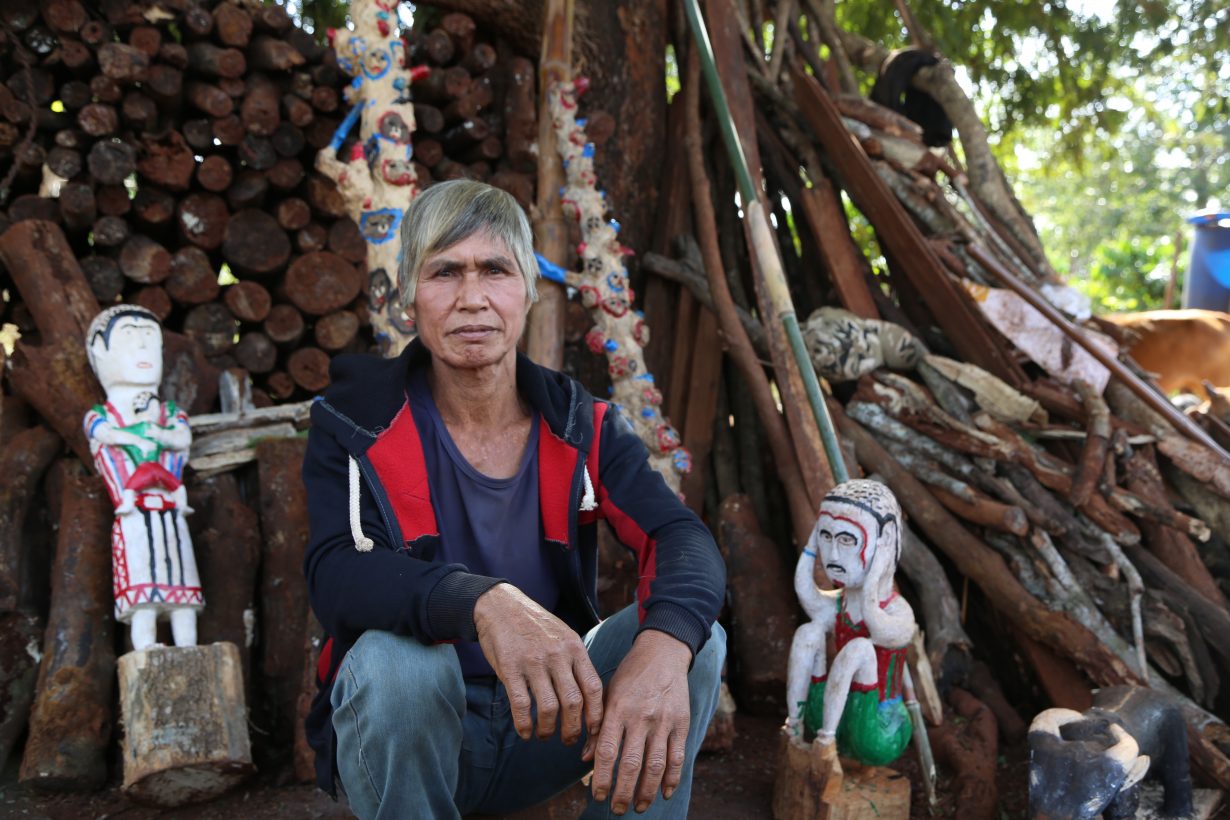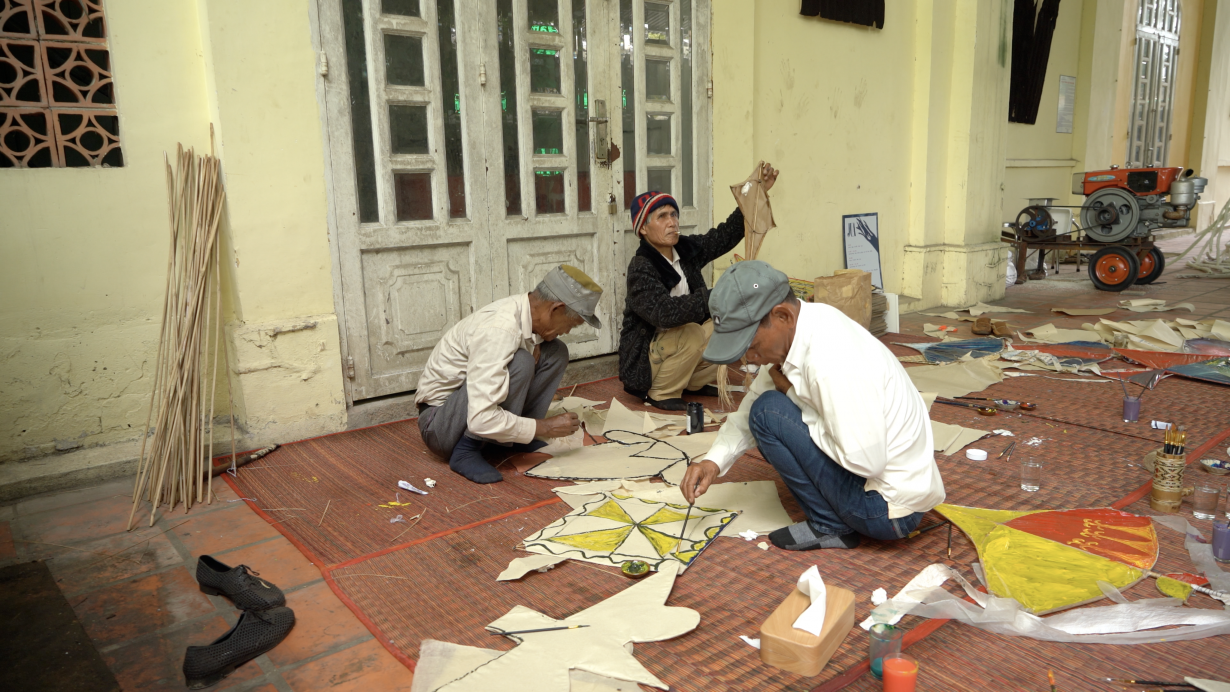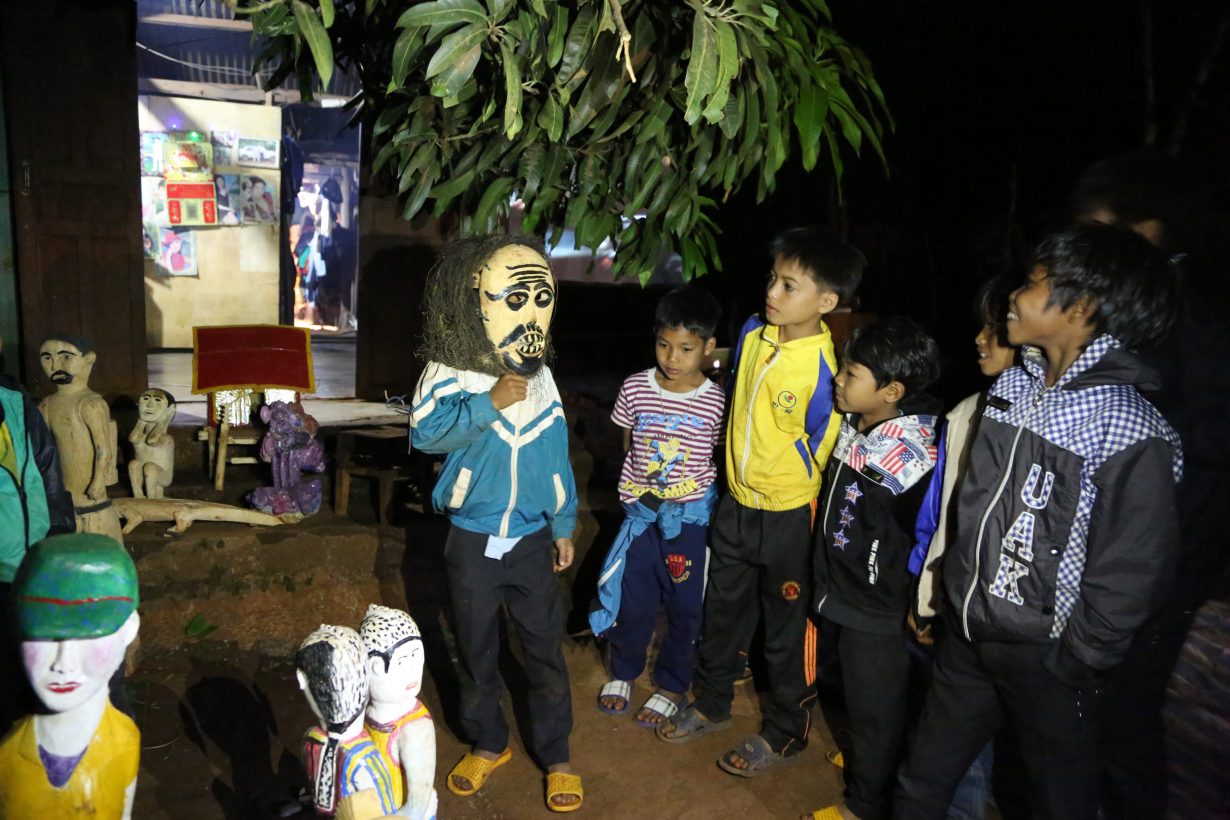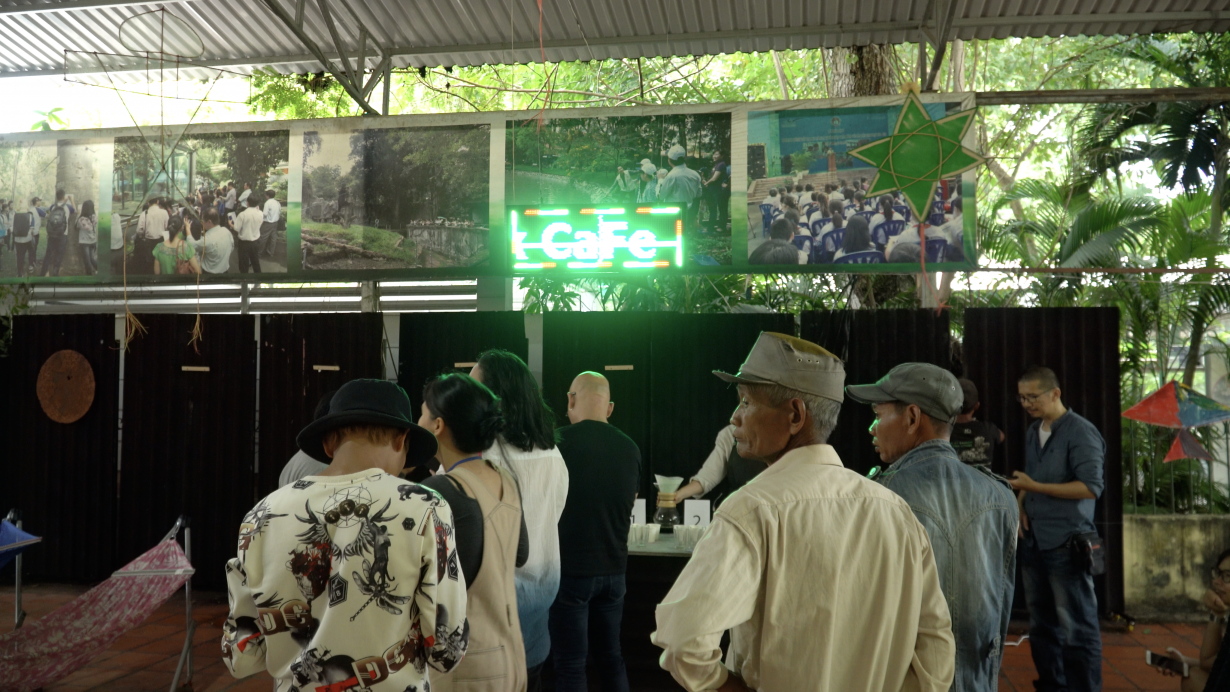The group describes its happenings, events and exhibitions as ‘seeds’, a vision that supports incremental, organic change across disciplines
In the language of the Jarai people, who are native to the Central Highlands of Vietnam, the word ‘jua’ refers to an elemental state that exists between water and air. This dynamic term can be used in reference to a stream, cloud or breeze, and could also describe breath or the wind. It forms the title of a series of exhibitions and events organised by the collective Art Labor, who have an ephemeral and hybrid nature to them. A one-day happening (more akin to a carnival than a typical art exhibition) that took place at Saigon Botanical Garden & Zoo in July 2019 was emblematic of their practice. Available for sampling were goods from the highlands, such as freshly ground Robusta coffee, brewed via the drip method rather than the more standard instant mix for which the bean is generally used, as well as bỏng gạo ống, a snack made from popped rice. Hammocks, a common feature of the roadside rest-spots used by those travelling along the highways of the Central Highlands, were set up in relaxation corners. Invited Jarai artists made sculptures from the roots of abandoned coffee trees, drawings with coffee grounds and kites from old gunny sacks used to transport beans.
Also included was a smallscale exhibition called Lai (Crossbred) that featured research carried out by Art Labor into the histories of coffee agriculture in Vietnam and rice cultivation in France. This took the form of a series of lenticular prints that create a holographic effect, merging together archival documents, such as old maps and images. Nearly a month later, in a talk at The Factory Contemporary Arts Centre, the artists expanded on their research relating to the migration of crops and people caused by colonial rule. In the eighteenth century, four types of coffee beans were introduced to Vietnam by the French, without much financial success. Yet after the Đổi Mới economic reforms were instituted by the Vietnamese government during the 1980s, the Central Highlands were designated as a coffee-growing zone and achieved commercial viability. Nonetheless, the plantations caused widespread ecological damage and the displacement of Indigenous populations – factors that contributed to ongoing land disputes.


Another little-known historical trajectory uncovered by Art Labor is the colonial exploitation that encompassed the cultivation of rice in France, which was pioneered by Vietnamese people forcibly recruited during the Second World War to work in arms factories in France and left stranded in the country after the war. These workers, called Công Binh (worker-soldiers), were ostracised by the Vietnamese for being traitors, and lived and worked in France under harsh conditions. They were the ones who started growing rice using traditional Vietnamese techniques in a wetland in southern France, the Camargue. Camargue rice now forms 75 per cent of France’s rice production, and the red variety is marketed as a superfood and a gourmet item.
Art Labor was formed in 2015 by artists Thao Nguyen Phan and Truong Cong Tung, and writer-curator-artist Arlette Quynh-Anh Tran, who describe the collective as ‘working in between visual arts, social and life sciences’. All three members are Kinh, the majority ethnicity in the country, and are based in Ho Chi Minh City. They also have solo careers that, in contrast to their social-practice work as a collective, are more conventional studio practices that produce art objects to be exhibited and sold in galleries and museums. Phan works in video, painting and installation, with an interest in sociopolitical histories and environmental issues in Vietnam, particularly the Mekong River area; her multilayered videos First Rain, Brise Soleil (2021–) and Becoming Alluvium (2019) explore the myths, histories and ecologies of the river and delta. Tran is primarily known as a curator and writer (who has also contributed to this magazine), but is having her first solo art exhibition about modernism and its political legacies at Gallery Medium in Ho Chi Minh City in September.

Saigon Botanical Garden & Zoo, Ho Chi Minh City
Tung is most connected to the highlands. His sculptures and video works engage with the materials and histories of the area, and the disruptions caused by the forces of modernity, colonialism and conflict. Many of his sculptural installations utilise soil from the highlands, as well as wood from tree species introduced there for industrial farming, such as coffee, avocado, rubber and cashew. His family also lives there. His grandparents were originally from coastal Vietnam and moved to the Đắk Lắk province in the highlands during the 1960s. During the 1990s, his parents moved to another highland province called Gia Lai to start coffee and pepper plantations, and as a result have firsthand experience of the complex changes undergone by the landscape and economy. When the Vietnamese government decided to make coffee a key agricultural industry, Tung’s family bought a section of pristine rainforest from the Jarai and cleared it for cultivation. During the early 2000s, when coffee prices plunged, many farms could not service loans they had taken out at high interest rates and either went bust or continued operating under crushing debt. Larger corporations moved in, buying up land from these smallholdings and consolidating them into larger businesses. Over the years, the highlands have seen the destruction of rainforests and the displacement of Indigenous populations, while migrant farmers have struggled with debt. Art Labor’s multifaceted efforts are an attempt to understand the intersecting forces that produced this contemporary reality, and their interventions provide new models for collaboration, empathy and healing.
Of course, the problems faced by the region are historical and systemic, and Art Labor is not in existence to resolve these complex issues. Rather, the group seeks to provide new ways of relating to history, as well as to each other. In the words of Phan: ‘Is there a way for a softer, gentler kind of contemporary life, one that shows respect to Indigenous knowledge and our ecosystem?’ On the group’s website, it describes its works as ‘seeds’. It is an analogy that highlights their overall vision: one that supports incremental, organic change across disciplines, through the creation of works that gather audiences and coproducers over a longer period. They write: ‘The seed grows – the inspiration expands and bears into a rhizome of collaborations, projects and artworks. In each activity new collaborators and/or mentors are added as additional partners to the collective varying from filmmakers, writers, visual artists, architects to farmers, folk artists, patients, scientists, and doctors.’

Art Labor defines their open-ended work as ‘multi-year journeys’, which are organised using themes inspired by Jarai cosmology. For instance, the Jrai Dew (2017–) event series refers to reincarnation: after death, the Jarai believe that we go through a process of living (and dying) again through seven different creatures before finally turning into dew, evaporating and then transforming into the basic particles that can incarnate as various other beings. Since 2017 Art Labor has been staging activities that echo this sense of constant metamorphosis. They have organised festivals in highland villages almost every year that celebrate local art and culture. Each edition may be slightly different in its offerings but nevertheless builds on community relationships established previously. Such events usually involve the sharing of food and drink, art workshops for children and lively performances.
Jarai wood-sculptors, who have traditionally made carvings of human figures placed around tombs, are long-standing collaborators. During one festival, Art Labor collected unwanted trees from coffee and rubber plantations (which had been uprooted to make way for new crops) and invited these artists to work with them. The result was a vibrant sculpture collection ranging from semiabstract works made from rugged roots to figurative pieces depicting people and animals. This ever-growing group of objects has travelled the world, thanks to Art Labor’s inclusion of them in exhibitions and festivals they curate or within which they participate.

Saigon Botanical Garden & Zoo, Ho Chi Minh City
This kind of social action work is not unique in Southeast Asia, where infrastructures can be less developed and projects by independent art collectives have the potential to fulfil wider functions than the expression of an individual artist. Groups such as Taring Padi and ruangrupa in Indonesia, Jiandyin from Thailand and the now-defunct AX(is) Art Project from Baguio in the Philippines produce works that offer alternative frameworks for social, economic and political engagement. Yogyakarta’s Taring Padi run children’s art workshops, host music performances and support the political causes of oppressed communities by making woodblock prints that gives visibility to ongoing struggles. Members of the AX(is) Art Project have organised art festivals and barter markets, and collaborated with Indigenous artists of the mountainous Cordillera region to make exhibitions of their carvings.
Art Labor’s social practice art operates in a similar vein. There are participatory events like food tastings, which entwine with a lineage of relational aesthetics (Rirkrit Tiravanija is a mentor), as well as more conventional exhibition-making. Art Labor’s showcase at Hong Kong’s Para Site this month, its first survey outside of Vietnam, will highlight the collective’s manifold roles as facilitators, curators, researchers and creators. The exhibition will explore the entanglement of existing binaries in the highlands, such as Indigenous cosmology and modernity, nature and technology, and art and anthropology. Phan will curate a selection of drawings by Jacques Dournes, a French missionary who lived in Vietnam from 1946 to 1970 and studied the culture of the Jarai and other highland ethnic groups – his ethnographic studies of the highland tribes are key – if not unproblematic – documents of their under-documented histories, lifestyles and beliefs. Tran will show a suspended structure of curved mirrors, onto which images of thermal images of hydroelectric dams in the highlands will be projected, creating a flickering, shimmering structure inspired by her feelings of awe and terror at huge machines. Meanwhile, Tung will present sculptures made from found objects and red soil collected from the highlands that look like relics from the past, as well as a future that has yet to be seen. There will also, of course, be wooden sculptures and sound installations by Jarai musicians and instrument makers. Hammocks will be set up for rest and conversation. Finally, as a social lubricant and material product of the complex historical forces that have shaped the highlands, the ever-present Robusta coffee will be served.
An exhibition of work by Art Labor and collaborators will be on view at Para Site, Hong Kong, from 16 August through 24 November
